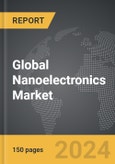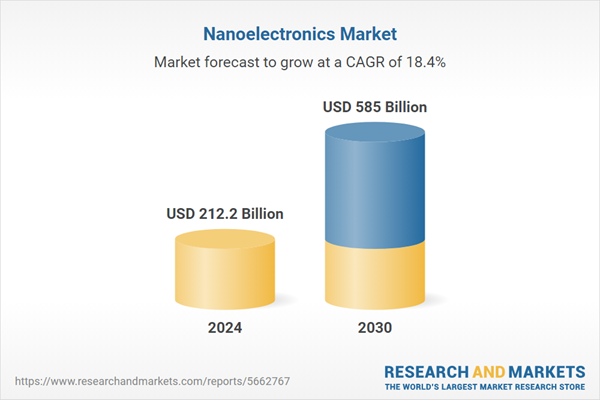The global market for Nanoelectronics was valued at US$212.2 Billion in 2024 and is projected to reach US$585.0 Billion by 2030, growing at a CAGR of 18.4% from 2024 to 2030. This comprehensive report provides an in-depth analysis of market trends, drivers, and forecasts, helping you make informed business decisions. The report includes the most recent global tariff developments and how they impact the Nanoelectronics market.
Segments: Type (Carbon Nanotubes, Graphene, Nanofibers, Nanosilver, Other Types); End-Use (Healthcare, Automobile, Telecom, Aerospace, Electronics).
Geographic Regions/Countries: World; United States; Canada; Japan; China; Europe (France; Germany; Italy; United Kingdom; and Rest of Europe); Asia-Pacific; Rest of World.
The analysts continuously track trade developments worldwide, drawing insights from leading global economists and over 200 industry and policy institutions, including think tanks, trade organizations, and national economic advisory bodies. This intelligence is integrated into forecasting models to provide timely, data-driven analysis of emerging risks and opportunities.
Global Nanoelectronics Market - Key Trends & Drivers Summarized
What Are Nanoelectronics and How Are They Transforming Technology?
Nanoelectronics refers to the use of nanotechnology in electronic components. This field involves the study and application of component parts that are typically less than 100 nanometers in size. The primary goal of nanoelectronics is to scale down electronic devices to microscopic sizes to enhance performance and functionality while reducing power consumption and physical space. This includes the development of transistors, capacitors, inductors, resistors, diodes, and even wires at the nanoscale level. The advancements in nanoelectronics have paved the way for significant breakthroughs in various sectors such as computing, healthcare, and telecommunications, revolutionizing traditional applications by making devices smaller, faster, and more efficient.How Are Advances in Material Science Impacting Nanoelectronics?
Innovations in material science play a crucial role in the evolution of nanoelectronics, particularly through the development and utilization of new nanomaterials. Graphene, carbon nanotubes, and quantum dots are prominent examples that have outstanding electrical, thermal, and mechanical properties, which make them ideal for electronic applications. Graphene, for instance, is a superb conductor of electrical and thermal energy and is incredibly strong while being lightweight. These characteristics are invaluable in developing faster, more efficient electronic components. Carbon nanotubes are used in the creation of smaller, more sensitive sensors, while quantum dots are employed in display technology to produce vibrant, more energy-efficient screens. These materials not only enhance the capabilities of electronic devices but also open up new avenues for innovations in nanoelectronic applications.What Trends Are Shaping the Nanoelectronics Industry?
The nanoelectronics industry is shaped by several key trends, most notably the increasing demand for portable and highly efficient electronic devices. As consumers and industries alike seek more power-efficient and high-performance electronics, nanoelectronics stands at the forefront of providing solutions that meet these needs. Additionally, the IoT (Internet of Things) revolution contributes significantly to the expansion of nanoelectronics, as billions of connected devices require integrated circuits and sensors that are compact and efficient. Furthermore, the advancement of wearable technology and medical devices that rely on sophisticated, miniature electronics for health monitoring functions is also driving the growth of nanoelectronics. Another trend is the automotive industry's shift towards electric and autonomous vehicles, which require advanced electronic systems and sensors to operate safely and efficiently.What Drives the Growth of the Nanoelectronics Market?
The growth in the nanoelectronics market is driven by several factors, including the relentless push for miniaturization alongside enhanced functionality and efficiency in electronic devices. As digital and smart device usage becomes more pervasive across all aspects of life, the demand for smaller components with increased capability continues to rise. Technological advancements that allow for the economical mass production of nanoscale devices also fuel market growth. Moreover, consumer behavior that increasingly leans towards high-performance, energy-efficient gadgets supports the expansion of the nanoelectronics field. Additionally, significant investments in R&D by governments and private entities worldwide are crucial in overcoming the technical challenges associated with developing nanoelectronic devices. These factors, combined with the critical need for advanced healthcare solutions and sustainable technologies, ensure robust growth in the nanoelectronics market, making it a key area of interest in the tech world.Report Scope
The report analyzes the Nanoelectronics market, presented in terms of units. The analysis covers the key segments and geographic regions outlined below.Segments: Type (Carbon Nanotubes, Graphene, Nanofibers, Nanosilver, Other Types); End-Use (Healthcare, Automobile, Telecom, Aerospace, Electronics).
Geographic Regions/Countries: World; United States; Canada; Japan; China; Europe (France; Germany; Italy; United Kingdom; and Rest of Europe); Asia-Pacific; Rest of World.
Key Insights:
- Market Growth: Understand the significant growth trajectory of the Carbon Nanotubes segment, which is expected to reach US$224.3 Billion by 2030 with a CAGR of a 20.7%. The Graphene segment is also set to grow at 19.0% CAGR over the analysis period.
- Regional Analysis: Gain insights into the U.S. market, valued at $57.7 Billion in 2024, and China, forecasted to grow at an impressive 16.9% CAGR to reach $86.1 Billion by 2030. Discover growth trends in other key regions, including Japan, Canada, Germany, and the Asia-Pacific.
Why You Should Buy This Report:
- Detailed Market Analysis: Access a thorough analysis of the Global Nanoelectronics Market, covering all major geographic regions and market segments.
- Competitive Insights: Get an overview of the competitive landscape, including the market presence of major players across different geographies.
- Future Trends and Drivers: Understand the key trends and drivers shaping the future of the Global Nanoelectronics Market.
- Actionable Insights: Benefit from actionable insights that can help you identify new revenue opportunities and make strategic business decisions.
Key Questions Answered:
- How is the Global Nanoelectronics Market expected to evolve by 2030?
- What are the main drivers and restraints affecting the market?
- Which market segments will grow the most over the forecast period?
- How will market shares for different regions and segments change by 2030?
- Who are the leading players in the market, and what are their prospects?
Report Features:
- Comprehensive Market Data: Independent analysis of annual sales and market forecasts in US$ Million from 2024 to 2030.
- In-Depth Regional Analysis: Detailed insights into key markets, including the U.S., China, Japan, Canada, Europe, Asia-Pacific, Latin America, Middle East, and Africa.
- Company Profiles: Coverage of players such as Buhler AG, Hewlett-Packard Development Company LP, Infineon Technologies AG, Intel Corporation, Koninklijke Philips NV and more.
- Complimentary Updates: Receive free report updates for one year to keep you informed of the latest market developments.
Some of the 23 companies featured in this Nanoelectronics market report include:
- Buhler AG
- Hewlett-Packard Development Company LP
- Infineon Technologies AG
- Intel Corporation
- Koninklijke Philips NV
- Robert Bosch GmbH
Tariff Impact Analysis: Key Insights for 2025
Global tariff negotiations across 180+ countries are reshaping supply chains, costs, and competitiveness. This report reflects the latest developments as of April 2025 and incorporates forward-looking insights into the market outlook.The analysts continuously track trade developments worldwide, drawing insights from leading global economists and over 200 industry and policy institutions, including think tanks, trade organizations, and national economic advisory bodies. This intelligence is integrated into forecasting models to provide timely, data-driven analysis of emerging risks and opportunities.
What’s Included in This Edition:
- Tariff-adjusted market forecasts by region and segment
- Analysis of cost and supply chain implications by sourcing and trade exposure
- Strategic insights into geographic shifts
Buyers receive a free July 2025 update with:
- Finalized tariff impacts and new trade agreement effects
- Updated projections reflecting global sourcing and cost shifts
- Expanded country-specific coverage across the industry
Table of Contents
I. METHODOLOGYII. EXECUTIVE SUMMARY2. FOCUS ON SELECT PLAYERSIII. MARKET ANALYSISIV. COMPETITION
1. MARKET OVERVIEW
3. MARKET TRENDS & DRIVERS
4. GLOBAL MARKET PERSPECTIVE
UNITED STATES
CANADA
JAPAN
CHINA
EUROPE
FRANCE
GERMANY
ITALY
UNITED KINGDOM
REST OF EUROPE
ASIA-PACIFIC
REST OF WORLD
Companies Mentioned (Partial List)
A selection of companies mentioned in this report includes, but is not limited to:
- Buhler AG
- Hewlett-Packard Development Company LP
- Infineon Technologies AG
- Intel Corporation
- Koninklijke Philips NV
- Robert Bosch GmbH
Table Information
| Report Attribute | Details |
|---|---|
| No. of Pages | 150 |
| Published | April 2025 |
| Forecast Period | 2024 - 2030 |
| Estimated Market Value ( USD | $ 212.2 Billion |
| Forecasted Market Value ( USD | $ 585 Billion |
| Compound Annual Growth Rate | 18.4% |
| Regions Covered | Global |









